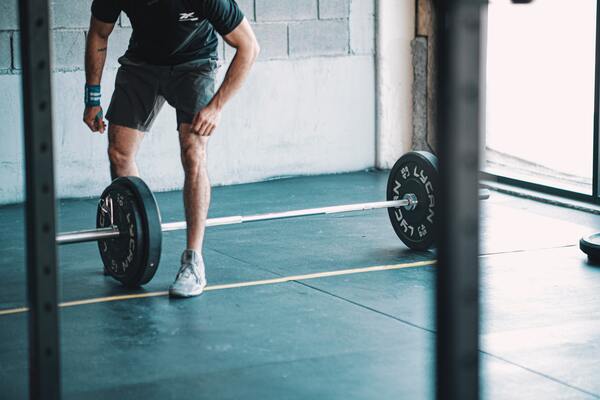Squats can help your body lose weight more quickly, have better muscle definition, and have a positive effect on your bones. Squats can also help you lose weight more quickly. It is obvious that you are performing squats incorrectly if they cause pain in your joints and muscles. Read the article and learn how to fix and prevent back pain when squatting.
What Are Squats
Squats, an exercise that targets the glutes, thighs, hips, calves, and legs, are a common component of traditional workout regimens. You can get different kinds of good results depending on how you do squats and how much weight you lift.
You must: in order to perform a traditional squat.
- Step forward with your toes while keeping your feet hip distance apart.
- Keep your hands and arms straight ahead (e.g., in a prayer position).
- Legs should be bent at a 90-degree angle. Sit back, weight on heels.
- When your thighs are parallel to the ground, stop.
- Don’t let your knees extend much past your toes.
- For about three seconds, maintain the position.
- Rise back up.
Due to a variety of variables, including fitness levels, body types, and objectives, these steps will probably vary from person to person. The fundamental procedures for performing a traditional squat, though, are as follows.
Benefits Of Squats
You might only be able to perform a couple of consecutive squats when you first start out. You can eventually gain the following advantages if you gradually increase the repetitions or weight:
Better posture
According to research, squats work your back muscles more than a plank. To maintain a more healthy posture, it’s crucial to develop these muscles.
Higher performance
A regular squatting routine has been shown to enhance your speed, strength, and endurance among other aspects of your athletic performance.
Weight loss
Squats build muscle and aid in calorie burning. You’ll be able to look and feel stronger and healthier as a result.

Healthier knee joints
Squats can help you develop the muscles that support your knees and absorb joint stress. If pain prevents you from moving, try doing softer squats (such as wall squats, where you lean your back against a wall for support).
Higher mineral bone density
Squats can improve bone mineral density when incorporated into a regular exercise program. Early development of stronger, denser bones can fend off diseases like osteoporosis later in life.
Reasons For Back Pain While Doing Squats
Your Technique Is All Wrong
To successfully complete a squat, you must maintain proper form. This is crucial to maintaining pain-free health as well as getting the most out of the workout. The way you hold your body during the squat is essential from the beginning to end.
You Already Have A Back Injury But Don’t Pay Heed To It
Squats and other exercises that might hinder the healing process should be stopped right away if we experience a lower back injury. Squats can still be performed as long as you are pain-free and want to keep your spine stable.
If your injury compromises spinal stabilization, lower back pain may develop. It’s best to hold off on doing squats in this situation until your injury has fully healed.
Your Hip Mobility Is Insufficient
If you don’t have the necessary ankle and hip mobility, squats will hurt. Your body adjusts to the seated posture because you spend the majority of the day in a fixed position and are supported by a chair, which causes muscle atrophy and a reduction in the dynamic range of the glutes and hip flexors, in particular.
Your Core Is Oh-so-weak
The stabilization of your spine is one of the most crucial aspects of squats because they put a lot of stress on your core muscles. If you don’t have enough strength in your core, stabilization can be challenging.
When your spine is loaded, as it is during a back squat, this is particularly true. Your lower back may hyperextend if you lack sufficient core strength. One of the most typical reasons for lower back pain when squatting is this.
Too Much Pressure
The lower back may become fatigued if you don’t regularly exercise and perform too many squats all at once. Your lower back may be working too hard, resulting in aches and pains, particularly if other muscles, like the glutes or thighs, aren’t strong enough yet.
How To Prevent Back Pain When You Squat
Squat Variations
Pick a squat variation that is suitable for you to begin with. Beginner-friendly variations like goblet squats or front squats are a good place to start if you’re new to squatting.
Notably, barbell back squats, where weight is loaded across the back, are the most frequently associated with back pain. A lot of shoulder and mid-back mobility, which we frequently lack, to begin with, is needed for this more difficult variation of the squat.
Starting Position
Make sure you are in the proper starting position before you start to squat. Your feet ought to be pointed forward. Your risk of hip and knee injuries increases if your feet are turned out at an angle.
Due to the foot arches collapsing inward, your knees become less stable, which will affect your form and may cause back pain.
Spinal Alignment
Maintaining a forward or upward gaze while squatting helps to ensure proper spinal alignment. This lessens the desire to lean too far forward, which puts more strain on the spine.
Make sure to keep good form and only squat as far as you feel in control. Instead of focusing on depth, more on form and control Squatting down too deeply may not be beneficial for everyone.
Joint Mobility
To facilitate balance and control in all aspects of the squat, a high degree of ankle mobility is necessary. When your knees are fully extended, you might notice that your heels lift off the ground if your ankle joint flexibility is compromised.
In order to avoid injury when squatting with more weight, you may compensate at your ankles, knees, hips, and spine. Just squat as far as you can safely manage, to reiterate. Improve your ankle flexibility in addition to squatting to help with technique.
What To Do If You Get A Sore Back After Squats
Stop Squatting
Avoid pushing through pain in your lower back. Take a break from squatting. You could stop working out entirely and concentrate on a different set of muscles. Never push through intense pain; instead, always pay attention to your body.
Instead, you can pause briefly and resume your workout when your body is ready. More than two days of pain could indicate something other than simple soreness from exercise.
Adjust Your Technique
The main focus of your training should be proper technique because it is a frequent source of injury. Pay attention to:
- Avoiding an arched back (tilt your pelvis forward to eliminate the arch)
- Favoring one side (distribute your weight evenly)
- Pushing your knees beyond the toes (they should be just above your feet)
Talk To A Professional
You might want to consult a healthcare professional, such as a personal trainer or physiotherapist if you frequently experience lower back pain when squatting.
Along with helping you with technique, a trainer can make it easier for you to incorporate squats into your exercise regimen.
You might need to start with a workout that is easier if your core strength is limiting you. Having an expert in your corner can help you progress much quicker than on your own
Lower The Weight
Lifting excessively heavy weights can put too much pressure on the lower back, similar to using improper technique. Make sure
you develop a strong base before pushing yourself too hard with weights.
Find out from your trainer how much weight you can squat while lifting. You can experiment with the weight if you don’t have access to a trainer. The best way to avoid lower back pain is to make gradual, smart increases.
Try To Manage The Pain
Your body may experience muscle soreness and aches as it recovers from squatting. To relieve your sore muscles, think about stretching and doing some exercises. Continue with gentle movement unless the pain is severe and incapacitating.
If you are in pain, try applying heat or ice to the area. Some people favor heat, while others cling to ice. If you’re unsure as to which one relieves your pain, try them both. Avoid applying heat or ice to your back for longer than 20 minutes at a time.
See A Doctor
Unremitting lower back pain may indicate more serious conditions. You might want to speak with your doctor and seek treatment if it doesn’t get better after 72 hours.
In the following situations, you should seek medical attention right away:
- You experience sharp lower back pain instead of a dull ache
- The pain radiates from the lower back to your legs (this could be a sign of nerve compression)
- You experience problems with bowel or urinary movements (coupled with lower back pain)
- You feel numbness or pins and needles in the glutes or the groin area
- Your pain is accompanied by fever
